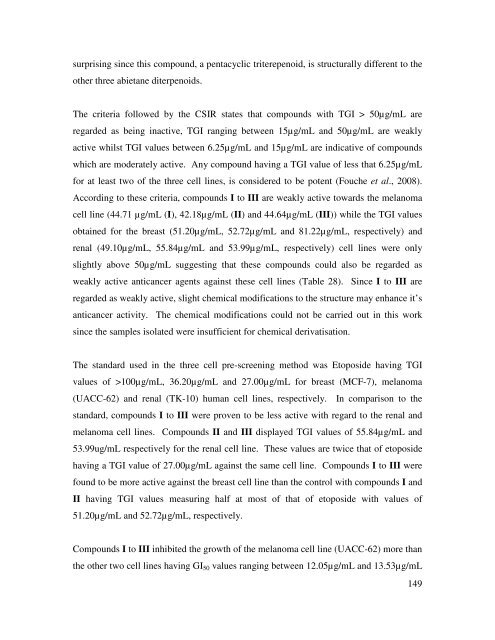university of kwazulu-natal faculty of science and agriculture school ...
university of kwazulu-natal faculty of science and agriculture school ...
university of kwazulu-natal faculty of science and agriculture school ...
You also want an ePaper? Increase the reach of your titles
YUMPU automatically turns print PDFs into web optimized ePapers that Google loves.
surprising since this compound, a pentacyclic triterepenoid, is structurally different to the<br />
other three abietane diterpenoids.<br />
The criteria followed by the CSIR states that compounds with TGI > 50µg/mL are<br />
regarded as being inactive, TGI ranging between 15µg/mL <strong>and</strong> 50µg/mL are weakly<br />
active whilst TGI values between 6.25µg/mL <strong>and</strong> 15µg/mL are indicative <strong>of</strong> compounds<br />
which are moderately active. Any compound having a TGI value <strong>of</strong> less that 6.25µg/mL<br />
for at least two <strong>of</strong> the three cell lines, is considered to be potent (Fouche et al., 2008).<br />
According to these criteria, compounds I to III are weakly active towards the melanoma<br />
cell line (44.71 µg/mL (I), 42.18µg/mL (II) <strong>and</strong> 44.64µg/mL (III)) while the TGI values<br />
obtained for the breast (51.20µg/mL, 52.72µg/mL <strong>and</strong> 81.22µg/mL, respectively) <strong>and</strong><br />
renal (49.10µg/mL, 55.84µg/mL <strong>and</strong> 53.99µg/mL, respectively) cell lines were only<br />
slightly above 50µg/mL suggesting that these compounds could also be regarded as<br />
weakly active anticancer agents against these cell lines (Table 28). Since I to III are<br />
regarded as weakly active, slight chemical modifications to the structure may enhance it’s<br />
anticancer activity. The chemical modifications could not be carried out in this work<br />
since the samples isolated were insufficient for chemical derivatisation.<br />
The st<strong>and</strong>ard used in the three cell pre-screening method was Etoposide having TGI<br />
values <strong>of</strong> >100µg/mL, 36.20µg/mL <strong>and</strong> 27.00µg/mL for breast (MCF-7), melanoma<br />
(UACC-62) <strong>and</strong> renal (TK-10) human cell lines, respectively. In comparison to the<br />
st<strong>and</strong>ard, compounds I to III were proven to be less active with regard to the renal <strong>and</strong><br />
melanoma cell lines. Compounds II <strong>and</strong> III displayed TGI values <strong>of</strong> 55.84µg/mL <strong>and</strong><br />
53.99ug/mL respectively for the renal cell line. These values are twice that <strong>of</strong> etoposide<br />
having a TGI value <strong>of</strong> 27.00µg/mL against the same cell line. Compounds I to III were<br />
found to be more active against the breast cell line than the control with compounds I <strong>and</strong><br />
II having TGI values measuring half at most <strong>of</strong> that <strong>of</strong> etoposide with values <strong>of</strong><br />
51.20µg/mL <strong>and</strong> 52.72µg/mL, respectively.<br />
Compounds I to III inhibited the growth <strong>of</strong> the melanoma cell line (UACC-62) more than<br />
the other two cell lines having GI50 values ranging between 12.05µg/mL <strong>and</strong> 13.53µg/mL<br />
149

















